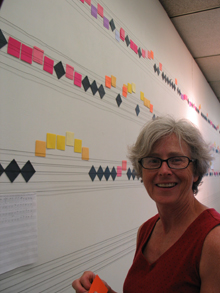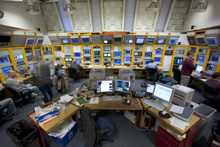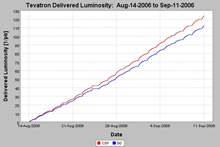 |
Tuesday, September 12
11:00 p.m. Computing Techniques Seminar - FCC 1
Speaker: T. Johnson, Stanford Linear Accelerator Center
Title: A Comprehensive Java-Based Simulation Environment
for Particle Physics
3:30 p.m. Director's Coffee Break - 2nd floor crossover
THERE WILL BE NO ACCELERATOR PHYSICS AND TECHNOLOGY
SEMINAR TODAY
Wednesday, September 13
11:00 a.m.
Fermilab ILC R&D Meeting -
1-West
Speaker: N. Graf, Stanford Linear Accelerator Center
Title: ILC Detector Simulations: Status, Issues,
Directions
3:30 p.m. Director's Coffee Break - 2nd floor crossover
THERE WILL BE NO FERMILAB COLLOQUIUM THIS WEEK
Click here for a full calendar with links to additional information.
|



Tuesday, September 12
-Tomato Bisque
-Lemon Pepper Club
-Burgundy Beef Tips
-Baked Fish Creole over Rice
-Grilled Chicken Cesar Wrap
-Assorted Slice Pizza
-Rio Grande Taco Salads
Wilson Hall Cafe Menu
|

Wednesday, September 13
Lunch
-Lebanese Kabob w/Pita
-Baba Ghannuj
-Hummus
-Tabbouli
-Baklava
Thursday, September 14
Dinner
-Puree Gloria
-Grilled Jumbo Shrimp
-Angel Hair Pasta Diavolo
-Sautéed Spinach w/Bacon
-Profiteroles
Chez Leon Menu
Call x4598 to make your reservation.
|


|
 |
| 'Moon Project' on display in the Fermilab Art Gallery
|
 |
|
Sallie Wolf arranged "Moon Song" in the Fermilab Art Gallery.
|
|
|
Artist Sallie Wolf remembers what it was like to be in art school in her mid-40s. With two children and a background in anthropology, not art, Wolf was awed by her collogues dedication to their projects. A guest speaker in her class had switched identities with a friend for a full year, exchanging jobs and girlfriends in the name of art, and another artist had collected 10,000 unbroken "A's" and "B's" from alphabet soup boxes. "It was art and I loved it," she said. "But I could not figure out how to put that kind of obsessive quality into something and still be a decent mom."
At first Wolf planned to use her new education to illustrate children's books. But in school she discovered artists like Alfred Jensen, who used numbers, calendars and other information as source material. Wolf realized she had plenty of information in her journals; she'd been recording the moon's movement every day. The obsessive quality she'd coveted was already in there. "A bunch of stuff came together," she said. Wolf's journal entries had half circles with tiny marks to note the position of the moon, and a tic-tac-toe-style north-south grid.
Wolf reproduced a full 10 years and 10 months of daily moon entries as one large art piece. More recently, she overlaid her tic-tac-toe grids with sheet music and let the position of the moon on each day's grid represent a musical note. "I had a family member who is a composer translate it to music for me," she said. "It turned out like a Gregorian Chant."
Moon Project will be on display in the Fermilab art gallery through November 1.
--Siri Steiner
There will be a reception for "Moon Project" on September 13 at 5:00 p.m. Wolf will give lectures in the Fermilab Art Gallery on September 15 at 2:00 p.m. and on October 11 at 7:00 p.m. You can learn more about her on the website.
|

 |
|
Records keep piling
up at the Tevatron: The Tevatron keeps setting records. On early Saturday morning, operators established collider store 4947 and pushed the peak luminosity of the Tevatron to 2.0E32 cm-2 s-1. The next store, initiated on Sunday afternoon, began with even higher peak luminosity, achieving almost 2.3E32. Compared to October 1, 2005, the beginning of the fiscal year, this is an improvement of 74 percent in peak luminosity.
The integrated luminosity has also done well. The accelerator complex has run with few interruptions during the last four weeks, producing a series of records. The current record for weekly integrated luminosity was established during the week of August 28, when the Accelerator Division produced 33.3 inverse picobarns, almost 60 percent more than the record in place a year ago. The week of September 4, the Tevatron broke the 30-pb-1 threshold for the second time.
A summary of the luminosity improvements is shown in these two graphs.
--Kurt Riesselmann
|
|
|
 |

| One thousand words
|
 |
Integrated luminosity for
the last four weeks reached a total of 118.1 inverse picobarns (average of CDF
and DZero). During this time, the two experiments accumulated two thirds of the total luminosity collected in all of Run I, which lasted four years.
|
|
|
|

CERN Press Release,
September 11, 2006:
CERN switches on neutrino beam to Gran Sasso
Geneva, 11 September 2006. CERN has switched on a new neutrino beam, aimed through the earth to the INFN Gran Sasso Laboratories some 730km away near Rome. This is the latest addition to a global endeavour to understand this most elusive of particles and unlock the secrets it carries about the origins and evolution of our Universe. The start of the project was marked today by a ceremony at the Gran Sasso Laboratories attended by Italian Minister for Universities and Research, Fabio Mussi, and CERN Director General Robert Aymar.
"CERN has a tradition of neutrino physics stretching back to the early 1960s," said Dr Aymar, "this new project builds on that tradition, and is set to open a new and exciting phase in our understanding of these elusive particles."
The CNGS beam and the experimental devices constructed in the Gran Sasso Laboratories to study neutrino interactions are part of a project aimed at shedding light on the mysterious phenomenon of the oscillation of these particles.
Neutrinos are continuously produced in nuclear reactions within the stars, and they are the most abundant particles in the Universe after photons. Our planet is constantly traversed by their flux: each second, 60 billion neutrinos go through a space the size of a fingertip. They interact so weakly with other particles that they can go through any form of matter without leaving a trace. This peculiarity makes neutrinos so elusive that a great sensitivity is required in the design of experiments to study them. Neutrinos are divided into three families: electron, muon and tau. Experimental evidence obtained through both cosmic and man-made neutrinos shows that they can oscillate from one type into another. This important phenomenon implies that each type of neutrino has a mass, and that the masses of the three types are different.
Read More |


Fermilab Arts and Lectures Newsletter
Now you can keep up on events at Fermilab with the new Arts and Lectures newsletter. Check it out here.
English country dancing
English country dancing will next meet on Sunday, September 24, at 2 p.m. in Kuhn Barn. The meeting date will change to the first Sunday of the month, beginning in November. Newcomers are welcome; partners and previous experience are not required. Please contact folkdance@fnal.gov or call 630-584-0825 or 630-840-8194.
Upcoming Activities |
|
|



